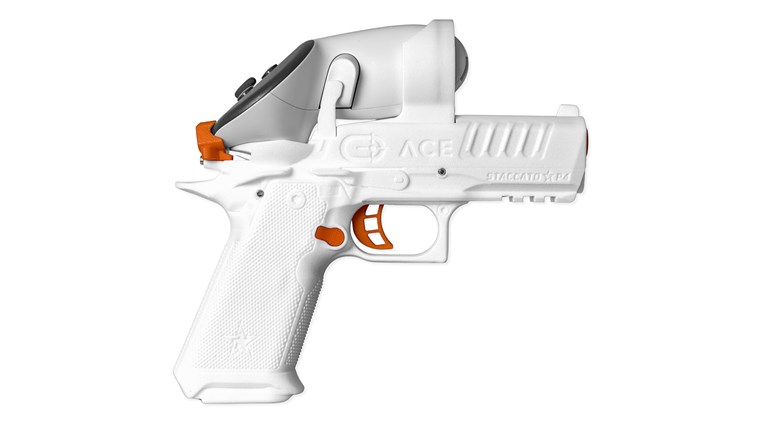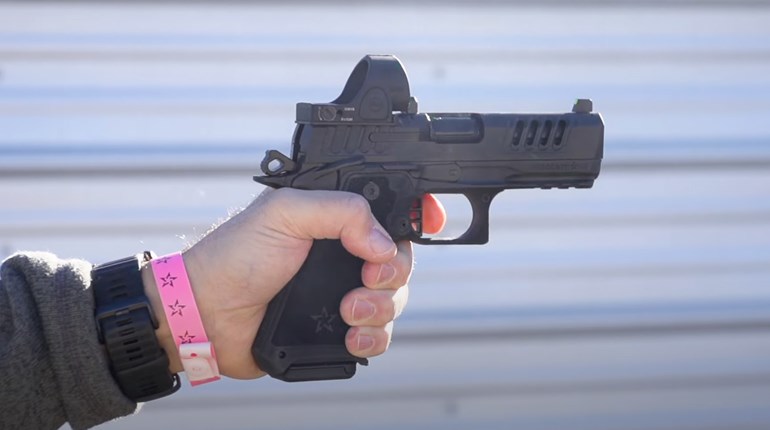
One of the challenges in bringing new shooters to the range is catching—and holding—their interest. There's a lot of material to cover for a new shooter; safety rules, proper stance, sight picture, etc. Just getting them used to the simple act of pulling the trigger will occupy a large chunk of their attention. Often, new shooters will fixate on the target, getting frustrated if they are unable to score hits directly in the X-ring. Or, they might not be able to see the target; especially if they're shooting rimfire at a respectable distance (farther than 25 yards). Punching holes in a paper target is fun, but add in reactive targets and the big-smile factor increases dramatically.
Folks with private ranges or permissive gun clubs can use a wide variety of reactive targets: milk jugs filled with water, tin cans, soda bottles, even old appliances can provide a target that provides feedback with every hit. Often, though, these targets can be messy and/or are disallowed in private gun clubs. A target that doesn't make a mess or require extensive cleanup would make a lot of sense, and this is where steel targets excel. The instant feedback—the distinctive ting—of a hit immediately lets shooters know their shot found its mark.
I got a chance to talk to the folks at MGM Targets at the SHOT Show this past January. The Idaho-based company makes a wide variety of targets, both steel and cardboard, with many options available for moving and stationary targets. I saw its line of auto-resetting targets, known as the Auto-Poppers, which have a strong steel spring that immediately returns a struck plate back to the upright position. It's a simple and elegant solution to the problem of resetting a steel plate—some units use a swinging or hanging plate to get around the need to reset, but these will take time to stop moving before a second shot can be taken.
MGM was kind enough to provide two different targets for testing, a .22 Rim Fire Auto-Popper and a Colt Speed Plate Auto-Popper. The rimfire plate is pretty self-explanatory, while the Colt Popper is designed with a larger 6-inch area for new shooters—just the thing needed to build the confidence of those being introduced to centerfire arms.
The rimfire popper works with .22 Short/Long/LR only, and for the centerfire plates, MGM recommends the following:
"For MGM 3/8-inch AR500 reactive targets, you can shoot pistol from 15 yards or more. Closer range risks frag bounce-back. Shoot rifle ammo up to 2,800fps/175-grain bullet, all steel/no steel or multi-core at 100 yards. While closer-range shooting is not recommended and may void warranty claims, if you want to shoot closer with a rifle, test two rounds then go look at target, minor pitting of the steel is common with some small-caliber, higher-velocity ammo. If you're shooting high velocity–over 2,800 fps, like .300 Win. Mag., or .338 Lapua Mag., as you know, those are long range rounds, so we always recommend shooting at a distance reasonable for the rifle and ammo, in this case, 200 yards or more. MGM 3/16-inch AR400 reactive targets can be shot with rimfire ammo at range of 15 yards or more."
The real test, of course, is in the shooting. Since we're looking at these autopoppers from the perspective of a new shooter, some video was shot to show them in action:
The plates were set up at the 50-foot station at my gun club, to ensure we covered the MGM recommended minimum distance of 15 yards. More than 250 rounds of .22 LR and about the same in .45 ACP, 9 mm, and .38 Spl. were shot against the respective targets, with the paint being the only casualty. The poppers performed beautifully as shown in the video, springing back into place immediately, ready for a second (third, fourth, etc.) shot. Even under rapid fire, the only issues were with the shooter, not the speed plates—they bounced back quickly and cleanly every single time. These targets do start moving, which is to be expected, and I found I had to reposition each popper roughly every 100 rounds. A small price to pay for steel shooting goodness.
The targets held up very well—after several sessions and multiple hundreds of rounds, they may have lost a bit of paint, but were otherwise in excellent shape and still ready for more. No pitting of any kind was observed, even with jacketed-hollow-point .357 Mag. rounds fired out of an 8 3/8-inch Smith & Wesson N-frame. Lead splatter from the rounds was quite evident in the wood block holding the .22 LR Auto-Popper and on the steel base of the centerfire popper, but other than cosmetic paint removal, these targets are 100-percent ready for the next set of shooters. Grab a can of white spray paint and they'll be good as new.
For new shooters—and experienced shooters, too—the instant feedback and immediate gratification of a reactive target is hard to beat. When building good firearm handling skills and developing proficiency on the range, it's very helpful to have a target that's easy to hit, provides instantaneous and audible confirmation and doesn't leave a mess. Steel targets fulfill all of these requirements, and the Auto-Popper line from MGM Targets has the additional benefit of not requiring folks to stop shooting to reset their targets. That's very useful when maintaining a new shooter's interest during their first trip to the range.





































